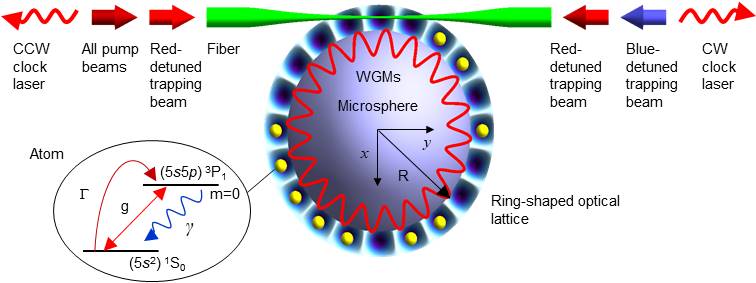Atomic clocks are the most stable and accurate time-keeping devices in the world. Optical clocks have surpassed their microwave counterparts in both stability and accuracy. Recently, increasing attention has been drawn towards their transportability/miniaturization. Optical clocks with compact size, reduced weight and low power consumption have broad out-of-the-lab applications, including satellite-based geo-positioning and communication engineering.
Most optical clocks are currently operated in the passive manner, where the local oscillator is pre-locked to a high-fineness optical resonator and is further stabilized to a narrow-line clock transition in atoms. Such configuration increases clock’s complexity and volume.
Recently, a joint research team from the National Time Service Center of the Chinese Academy of Sciences (NTSC) and the University of Exeter proposed an active optical microclock based on the lattice-trapped atoms evanescently interacting with a whispering-gallery-mode (WGM) microcavity. The numerical simulation illustrates that the microclock's frequency stability potentially reaches 1.5×10-14 at 1 s of averaging.
The results were published in Quantum Science and Technology on Jan. 30
The active microclock is actually a bad-cavity laser, in which the intercombination transition in strontium is employed as the clock (laser) transition whose spectral bandwidth is much narrower than that of the optical WGM in microcavity. The cavity pulling effect, which strongly influences the central frequency of conventional lasers, is substantially suppressed.
"Unlike the conventional passive clock scheme, the active operation directly produces the optical frequency standard without the need of extra laser stabilization, substantially simplifying the clock configuration," said prof. YU, the first author of this study.
The research result showed that the microclock's frequency stability over one order of magnitude better than the recently demonstrated chip-scale optical clock that is built upon rubidium vapor cell and also more stable than current cesium fountain clocks and hydrogen masers.

Active whispering-gallery microclock, where lattice-trapped strontium atoms are evanescently coupled to a microsphere.
CONTACT:
XIONG Tiantian
National Time Service Center, Chinese Academy of Sciences
gjhz@ntsc.ac.cn
 Print
Print